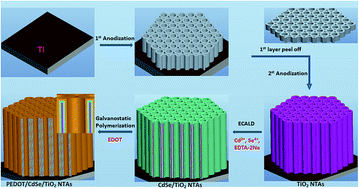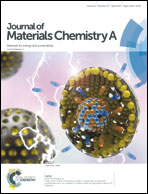Epitaxial hetero-structure of CdSe/TiO2 nanotube arrays with PEDOT as a hole transfer layer for photoelectrochemical hydrogen evolution†
Abstract
The photocatalytic decomposition of water is believed to be able to help mitigate the crisis of fossil fuel depletion. However, obtaining high and stable photoconversion efficiency remains a challenge in photocatalytic hydrogen production. Here we report an epitaxial hetero-structure of CdSe/TiO2 nanotube arrays as efficient photo-anodes via simple, room-temperature, low-cost electrochemical deposition. With the help of a similar d spacing to TiO2, the CdSe sensitizing layer is epitaxially grown on the tube wall of the TiO2 nanotubes, resulting in an ideal coherent grain boundary and single crystal growth. The resultant photo-anode produces 30% more photocurrent than those samples without a coherent grain boundary. Notably, the especial epitaxial hetero-structure is beneficial to decrease the recombination site and accelerate the separation of photogenerated electron–hole pairs. Furthermore, an ultrathin PEDOT surface layer was developed on the epitaxial hetero-structure of CdSe/TiO2 nano-tube arrays in which it functions as both a physical passivation barrier and a hole transfer layer. As a result, significantly enhanced photocurrent density and substantially better stability have been achieved. This methodology may provide a new pathway of epitaxial growth for preparing heterogeneous junction materials which have similar d spacing.



 Please wait while we load your content...
Please wait while we load your content...